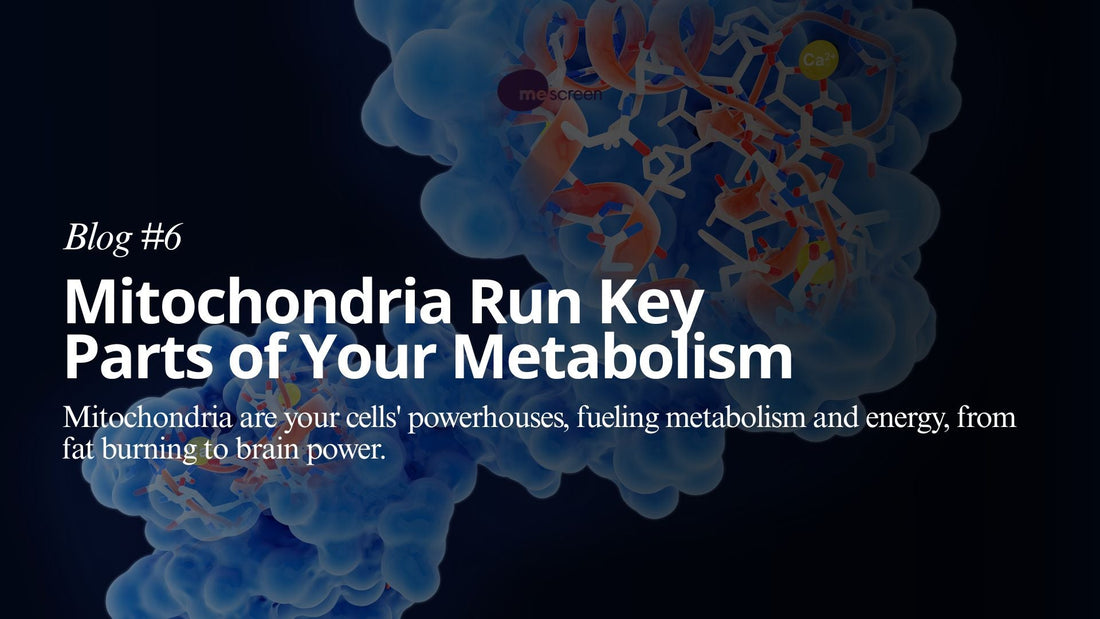Understanding Mitochondrial Health: A Weekly Learning Series
🔋 Mitochondria Run Key Parts of Your Metabolism
When you think about energy, you might picture food, exercise, or maybe your morning coffee ☕. But deep inside your cells, there’s a microscopic powerhouse making all of that possible: the mitochondrion.
Often called the “powerhouse of the cell” 🏭, mitochondria do far more than just pump out energy. They run key parts of your metabolism and play a vital role in your overall health, from how well you burn fat to how sharp your brain feels.
🧬 What Are Mitochondria?
Mitochondria (singular: mitochondrion) are tiny, double-membraned organelles found in nearly every cell in your body 🧫. They evolved from ancient bacteria through a process called endosymbiosis and still carry their own DNA, separate from the nucleus.
This unique origin gives mitochondria a central role in managing energy and regulating key metabolic functions.
⚙️ How Mitochondria Power Your Body
At the core of mitochondria’s job is a process known as cellular respiration, specifically a stage called oxidative phosphorylation. This is how your body transforms food into usable energy:
- 🍞 Fuel Breakdown: Carbohydrates, fats, and proteins are broken down into molecules like glucose and fatty acids.
- 🔁 Energy Conversion: These molecules enter the Krebs cycle inside the mitochondria.
- ⚡ ATP Production: Through the electron transport chain, mitochondria produce ATP — the energy currency that powers almost every cellular process.
Without ATP, your muscles wouldn’t move 💪, your brain wouldn’t think 🧠, and your heart wouldn’t beat ❤️.
🧠 Mitochondria and Metabolic Health
Healthy mitochondria burn fuel cleanly and efficiently. But when they aren’t functioning properly, your metabolism suffers. You might feel it as:
- Chronic fatigue 😴
- Weight gain or difficulty losing weight ⚖️
- Insulin resistance and blood sugar issues 🍬
- Higher risk of chronic diseases like diabetes and Alzheimer’s 🧓
Research shows that regular exercise and intermittent fasting can improve mitochondrial function and even trigger mitochondrial biogenesis — the creation of new mitochondria. Think of it like upgrading your body’s internal engines 🔧.
🧨 Mitochondrial Dysfunction: A Root Cause of Disease?
More and more research points to mitochondrial dysfunction as a contributor to major diseases — not just metabolic disorders like type 2 diabetes, but also neurodegenerative diseases (like Parkinson’s and Alzheimer’s), cardiovascular disease, and even some cancers.
Contributors to mitochondrial damage include:
- 🧪 Oxidative stress
- 🍔 Poor diet
- ☣️ Environmental toxins
- 🕑 Aging
When mitochondria are damaged, energy production declines and cellular waste builds up — leading to a downward spiral in health.
🛡️ How to Support Your Mitochondria
Luckily, there are science-backed ways to protect and enhance mitochondrial function:
- ✅ Exercise regularly (especially cardio and resistance training)
- ✅ Eat antioxidant-rich foods (leafy greens 🥬, berries 🫐, nuts 🌰)
- ✅ Avoid excess sugar and processed foods
- ✅ Get quality sleep and manage stress 🛌🧘
- ✅ Consider nutrients like CoQ10, alpha-lipoic acid, magnesium, and B vitamins (consult your doctor first) 💊
🏁 Conclusion
Your mitochondria do so much more than power your cells — they run the engine of your entire metabolism. Whether you’re trying to boost energy, lose fat, or prevent disease, focusing on mitochondrial health is a smart place to start.
Take care of your mitochondria, and they’ll take care of you. 🔄💚
📚 References
- Margulis, L. (1970). Origin of Eukaryotic Cells. Yale University Press.
- Nicholls, D. G., & Ferguson, S. J. (2013). Bioenergetics 4. Academic Press.
- Petersen, K. F., & Shulman, G. I. (2006). "Etiology of insulin resistance." American Journal of Medicine, 119(5 Suppl 1), S10-S16.
- Hood, D. A. (2001). "Contractile activity-induced mitochondrial biogenesis in skeletal muscle." J Appl Physiol, 90(3), 1137–1157.
- Wallace, D. C. (2005). "A mitochondrial paradigm of metabolic and degenerative diseases." Annual Review of Genetics, 39, 359–407.

